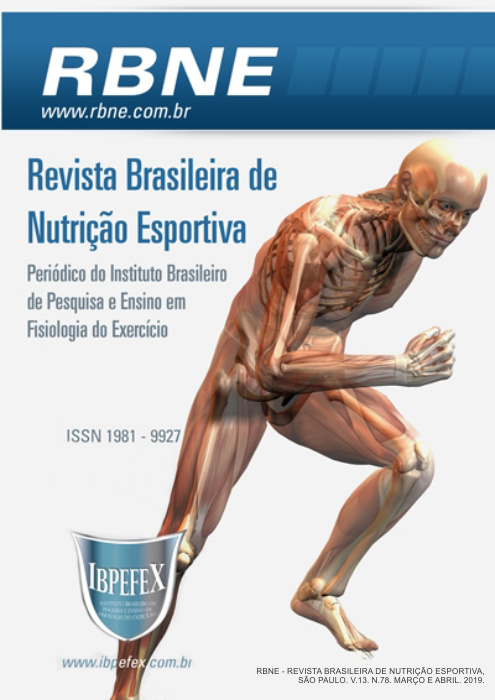Perfil antropométrico de bailarinos clássicos profissionais de uma escola de dança
Resumo
O ballet clássico é uma dança base para todas as outras, onde o principal instrumento utilizado pelo bailarino é o seu próprio corpo. Há constante busca por uma imagem corporal bem específica, que supervaloriza a estética. Este estudo avaliou a composição corporal e o estado nutricional de bailarinos clássicos profissionais. Participaram 30 indivíduos entre 12 e 32 anos, de ambos os sexos, de uma escola pública de dança, da cidade de Goiânia (GO). Foram aferidos peso, altura, circunferências e dobras cutâneas. A mediana do IMC para o sexo feminino foi maior que a do sexo masculino. Verificou-se predomínio de eutrofia entre adolescentes e adultos para ambos os sexos, quando avaliado o estado nutricional pelo IMC. A maioria dos adolescentes foram classificados com percentual de gordura corporal (%GC) baixo em ambos sexos. Na população adulta, a maioria dos homens foram classificados com %GC muito baixo. Logo, os bailarinos devem ser orientados acerca de sua alimentação, para que alcance os objetivos estéticos proposto pelo ballet clássico, porém sem prejuízos à saúde. Novos estudos devem ser realizados com foco no perfil antropométrico, para maiores comparações e comprovações científicas.
Referências
-AngioI, M.; Mmetsios, G.; Kouredakis, Y. W., MA. Fitness in contemporary dance: a systematic review. Int J Sports Med. Vol. 131. Num. 7. 2009. p. 475-484.
-Bianchini, L.; Brandão, A.; Liberali, R.; Navarro, F. Análise da Diferença nas Circunferências de Membros Inferiores e Superiores de Atletas de Voleibol de Praia do Estado de Santa Catarina. Revista Brasileira de Prescrição e Fisiologia do Exercício. São Paulo. Vol. 5. Num. 30. 2011. p. 548-553. Disponível em: <http://www.rbpfex.com.br/index.php/rbpfex/article/view/399>
-Brasil. Conselho Nacional de Saúde. Resolução 466/12. Trata de pesquisas em seres humanos e atualiza a resolução 196. Diário Oficial da União. 12 dez. 2012.
-Callaway, C.W; Chumlea, W.C; Bouchard, C; Himes, J.H; Lohman, T.G; Martin, A.D; Mitchel, L.C.D; Mueller, W.H; Roche, A.F; Seefeldt, V.D. Circunferences. IN Lohman, T.G; Roche, A.F; Martorell, R. Antropometric Standardization Reference Manual. Illinois: Human Kinetics Books. 1988.
-Dourado, C.P; Santos, J.L; Soares, B.M; Baratto, I; Santos, E.F; Bonnemann, G.D. Perfil Nutricional de Adolescentes Praticantes de Balé Clássico do Município de Guarapuava/Paraná. São Paulo. Vol. 6. Num. 35. 2012. p. 398-406.
-Gordon, C.C; Chumlea, W.C; Roche, A.F. Stature, recumbent length, and weight. IN Lohman, T.G; Roche, A.F; Martorell, R. Antropometric Standardization Reference Manual. Illinois: Human Kinetics Books. 1988.
-Guedes, D.P. Manual Prático para avaliação em educação física. Barueri: Manole, 2006.
-Harrison, G.G.; Buskirk, E.R.; Carter, J.E.L.; Johnston, F.E.; Lohman,T.G.; Pollock, M.L.; e colaboradores. Skinfold thicknesses and measurements technique. In:Lohman, T.G; Roche, A.F; Martorell, R. Anthropometric standardizing reference manual. Champaign (Illinois): Human Kinetics Books. 1991.
-Hidayah, G. N.; Bariah, A. H. Eating attitude, body image, body composition and dieting behaviour among dancers. Asian Journal of Clinical Nutrition. Islamabad. Vol. 3. Num. 3. 2011. p. 92-102.
-Jackson, A.S.; Pollock, M.L. Generalized equations for predicting body density of men. British Journal of Nutrition. Cambridge. Vol. 40. Num. 1. 1978. p. 497-504.
-Kuawae, C.A.; Silva, M.S. Hábito Alimentar e Composição Corporal de bailarinos contemporâneos e do Balé Clássico. Colégio Brasileiro de Ciências do Esporte. 2007.
-Ministério da Saúde. Protocolos do Sistema de Vigilância Alimentar e Nutricional –SISVAN na assistência à saúde. Brasília: Ministério da Saúde, 2008.
-Moura, U.I.S; Mendes, L.R; Silva, I.P.O; Ângelo, R.C.O; Schwingel, P.A. Consumo Alimentar, Perfil Antropométrico e Imagem Corporal de Bailarinas Clássicas do Vale do São Francisco. Revista Brasileira de Nutrição Esportiva. São Paulo. Vol. 9. Num. 5. 2015. p. 237-246. Disponível em: <http://www.rbne.com.br/index.php/rbne/article/view/533>
-Paulino, B.C; P.; Navarro, A.C. Avaliação do Consumo Calórico e Distribuição de Macronutrientes na Alimentação Habitual de Bailarinos da Cia de Dança Sesi minas em Relação às suas Necessidades Nutricionais. Revista Brasileira de Nutrição Esportiva. São Paulo. Vol. 8. Num. 47. 2014. p. 336-342. Disponível em: <http://www.rbne.com.br/index.php/rbne/article/view/473>
-Ribeiro, L.G; Veiga, G.V. Imagem Corporal e Comportamentos de Risco para Transtornos Alimentares em Bailarinos Profissionais. Rev Bras Med Esporte. São Paulo. Vol. 16. Num. 2. 2010. p. 99-102.
-Rojas, E.M; Urrutia, A.R.G. Estado Nutricional de bailarinas de ballet clássico, área metropolitana de Costa Rica. Ver costrric salud pública. Vol. 18. Num. 33. 2008. p. 1-7.
-Santos, J.A.; Amorim, T. Desafios nutricionais de bailarinos profissionais. Revista Portuguesa de Ciências do Desporto. Porto. Vol. 14. Num. 1. 2014. p. 112-126.
-Siri, W.E. Body composition fron fluid spaces and density: analysis of methods. IN Brozek, J; Henschel, A Techniques for Measuing Body Composition Whashigton, DC: National Academy. Human Biology. Vol. 60. 1988. p. 223-224.
-Slaughter, M. H.; Lohman, T. G.; Boileau, R. A.; Horswill, C. A.; Stillman, R. J.; Vanloan, M. D.; e colaboradores. Skinfold equations for estimation of body fatness in children and youth. Human Biology. Vol. 60. 1988. p. 709-723.
-Tirapegui, J.; Ribeiro, S.M.L.R. Avaliação nutricional: teoria e prática. Rio de Janeiro. Guanabara Koogan. 2009. p. 326.
-World Health Organization (WHO). Child Growth Standard. Geneva. WHO 2007. p. 217.
-World Health Organization (WHO). Obesity: preventingand managing the global epidemic. WHO Technical Report Series, Geneva. 1997. n. 894.
Autores que publicam neste periódico concordam com os seguintes termos:
- Autores mantém os direitos autorais e concedem ao periódico o direito de primeira publicação, com o trabalho simultaneamente licenciado sob a Creative Commons Attribution License BY-NC que permitindo o compartilhamento do trabalho com reconhecimento da autoria do trabalho e publicação inicial neste periódico.
- Autores têm autorização para assumir contratos adicionais separadamente, para distribuição não-exclusiva da versão do trabalho publicada neste periódico (ex.: publicar em repositório institucional ou como capítulo de livro), com reconhecimento de autoria e publicação inicial neste periódico.
- Autores têm permissão e são estimulados a publicar e distribuir seu trabalho online (ex.: em repositórios institucionais ou na sua página pessoal) a qualquer ponto antes ou durante o processo editorial, já que isso pode gerar alterações produtivas, bem como aumentar o impacto e a citação do trabalho publicado (Veja O Efeito do Acesso Livre).






